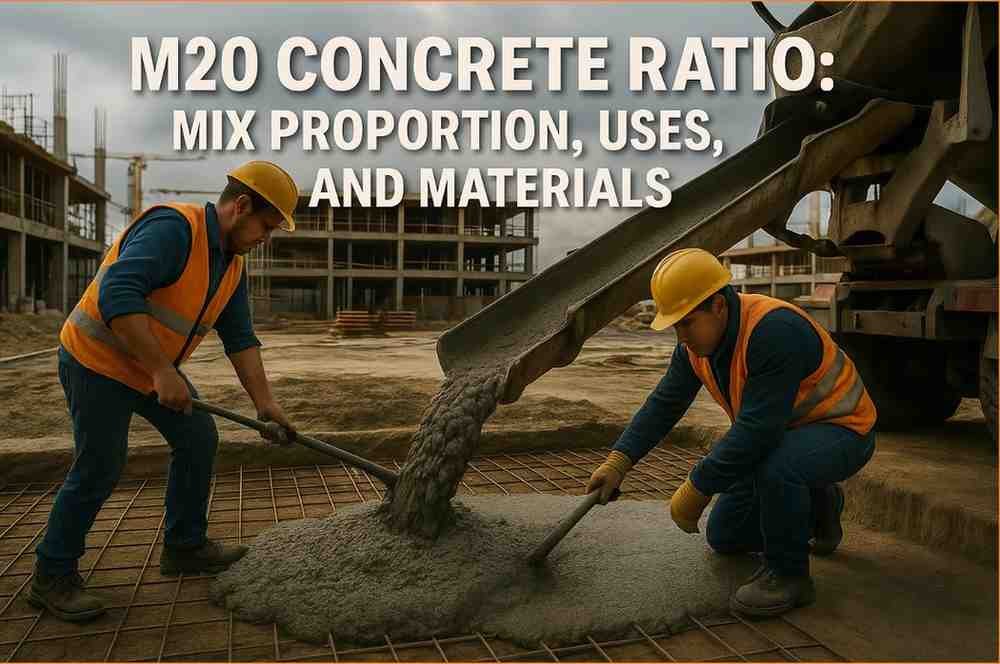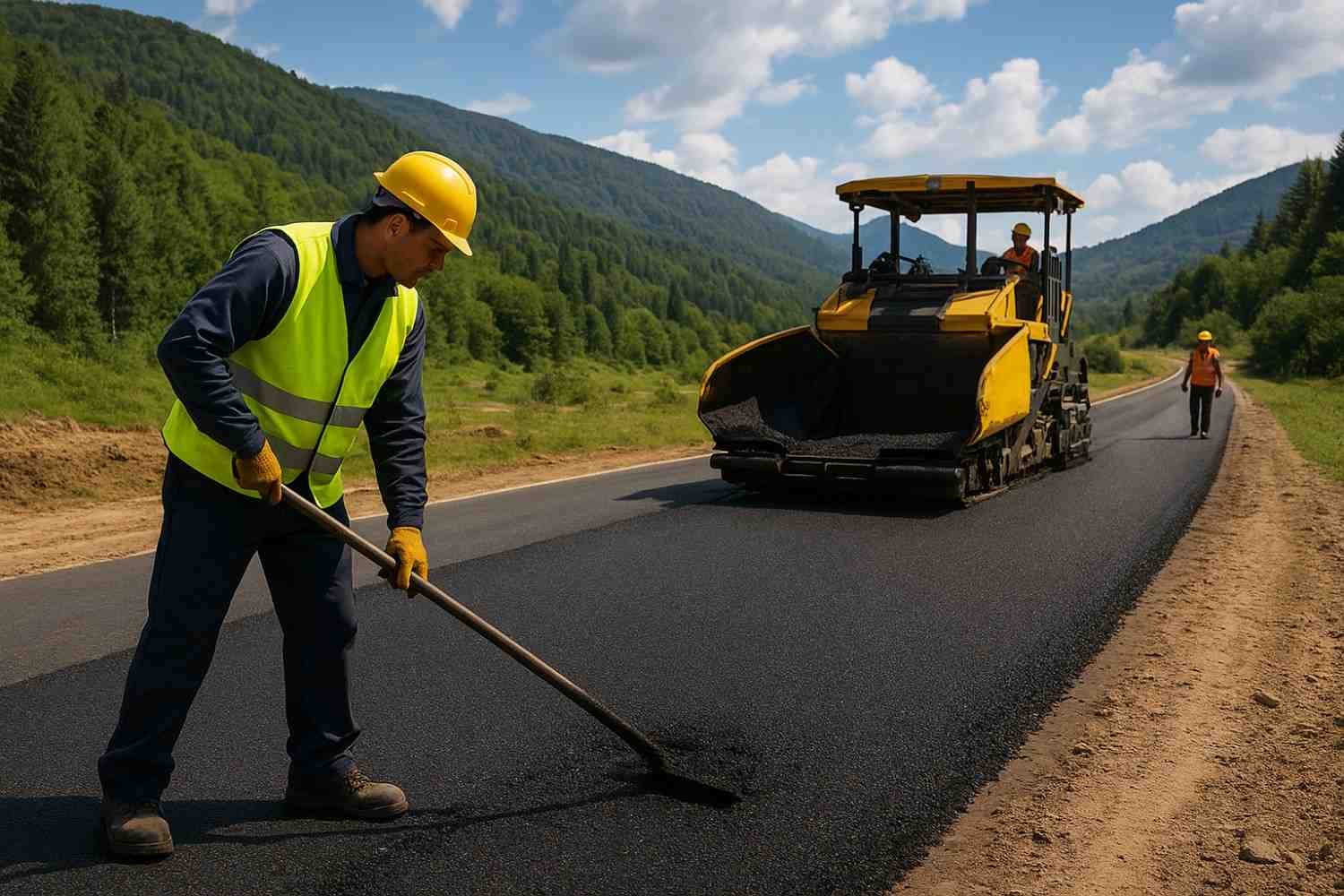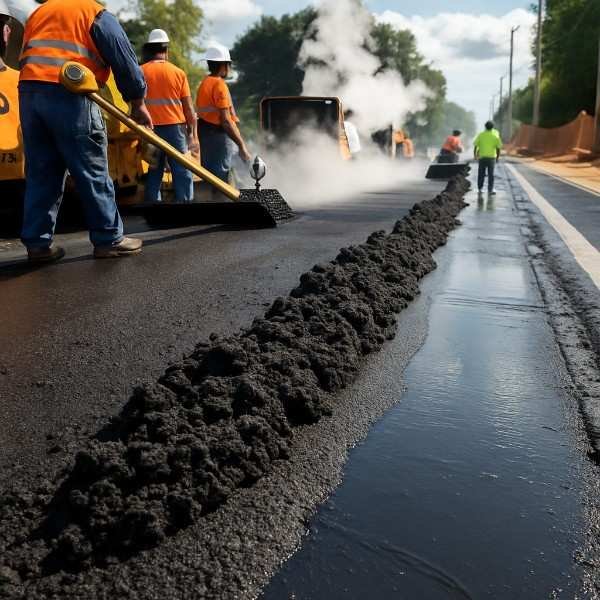Overview
Concrete is made by mixing cement, sand, aggregate (crush stone) and water. M20 grade refers to concrete designed to reach about 20 MPa strength after it hardens (28 days). The letter M stands for mix, and 20 is its strength unit (MPa). Builders often use M20 for beams, columns, footings and slabs in homes and small buildings. In the sections below, we explain M20 concrete, its mix ratio, how to prepare it and important tips for work sites.
What is M20 concrete?
M20 is a grade of concrete. A concrete grade tells you how strong it will be after about 28 days of curing. For example, "20 MPa" (20 N/mm²) means the concrete can handle a certain load before breaking. After M25 concrete mix, M20 concrete mix is considered a "high" strength concrete. It is common for ordinary building work. For instance, builders use M20 concrete in structural parts of houses - like footings, foundations, columns, beams and slabs. These parts need concrete that is strong and durable but do not require the super-high strength of special mixes. In other words, M20 is a balanced mix: strong enough for medium loads and affordable for routine construction.
Why concrete grades are important
Choosing the right concrete grade (mix) is very important for safety and durability. The grade tells you the mix's strength when it hardens. If a part of a building needs strong concrete (like a heavy support pillar), you must use the correct grade. Using a weaker mix than designed can cause cracks or even collapse. On the other hand, using a much stronger grade than needed can waste money.
In practice, engineers calculate what loads each part of a structure will carry. They then pick a grade like M20 so the concrete mix will meet those strength needs. By following the specified grade and mix ratio, builders ensure the building will stand for a long time. As one technical guide notes, "Precise measurements are necessary to achieve the right M20 mix" and make sure the structure stays strong. In short, concrete grades matter because they match mix strength to the job, keeping construction safe and durable.
What is the M20 concrete ratio?
The M20 concrete ratio refers to the proportion of ingredients used for this grade. For M20, the standard ratio of cement : sand : coarse aggregate (gravel or crushed stone) is 1 : 1.5 : 3 by volume. This means for each one part of cement; you use 1.5 parts of sand and 3 parts of gravel. For example:
- 1 bucket of cement (cement is the binding agent)
- 1.5 buckets of sand (fine aggregate)
- 3 buckets of gravel or stones (coarse aggregate)
When mixed, these parts will give a concrete that reaches about 20 MPa of strength. (The water is then added to make the mix workable - see below.)
In addition, the water-cement ratio is usually kept around 0.4-0.6 for M20 concrete. That means the weight of water is about 40-60% of the weight of cement. For practical use, you add clean water slowly until the mix has the right wetness. Too much water can weaken the concrete; too little water makes it hard to mix.
Materials required for M20 mix
To prepare M20 concrete, gather the following materials:
- Cement: Ordinary Portland Cement is commonly used. Use good-quality cement (check date and storage).
- Sand: Clean, coarse sand (fine aggregate) free of clay or organic matter.
- Coarse aggregate: Clean gravel or crushed stone (about 10-20 mm size) with no mud or dust.
- Water: Clean, fresh water (potable water is ideal).
You will measure these by volume. For example, one way is to use a one-bucket or one-spade method to measure each part. Be consistent. For one cubic metre of M20 concrete, you would use roughly about 8 bags of cement (50 kg bags), 0.42 m³ of sand, and 0.84 m³ of gravel. The water should be about 0.45-0.5 times the weight of cement (so roughly 20-25 litres per 50 kg bag, depending on conditions) to achieve a workable mix.
The key is to keep the 1 : 1.5 : 3 ratio. If you need to make a smaller batch, scale each ingredient in these proportions. Always use clean materials and accurate measurement.
Mixing procedure
Follow these steps to mix M20 concrete properly:
- Measure and prepare: Make sure you have all materials. Set out a clean mixing area (a mixing tray, wheelbarrow, or mechanical mixer). Lightly wet the mixing surface if it's very dry, to prevent cement from sticking.
- Dry mix: First, put the cement, sand and course aggregate together in the mixer or on the tray. Mix them dry (without water) thoroughly. Turn and stir the mixture many times. Do this until the colour of the mix is uniform. Dry mixing ensures the cement coats the sand and gravel evenly.
- Add water slowly: Gradually add clean water to the dry mix while you continue mixing. Don't pour all the water at once. Mix a little, then add some water, mix and so on. The idea is to get a workable mix that is wet enough to pour.
- Important: Add just enough water for workability. Too much water will weaken the concrete, and too little water will make it stiff and hard to work. The mix should be damp and plastic, not soupy.
- Achieve consistency: Keep mixing until the concrete is smooth and uniform. It should hold together when you scoop it. There should be no dry powder clumps, and all gravel and sand should be coated. This usually takes a few minutes of mixing by shovel or machine.
- Use quickly: Concrete begins to set after some time. Once you add water and finish mixing, pour or place the concrete as soon as possible (ideally within 15-30 minutes). If it sits too long, it will start hardening and become difficult to work.
By following these steps, you ensure each part is well-blended. Technical guides emphasize that "Mixing M20 concrete requires precise measurements and a clear understanding of the components".
Tips for site use
- Safety first: Always wear gloves, boots, and eye protection. Cement is caustic and can irritate skin or eyes. A dust mask can help if mixing by hand.
- Tools: Use a sturdy shovel or hoe (and a mixer if available). Clean your tools before starting and after finishing each batch.
- Check the mix: If possible, do a simple slump check (shape the wet concrete and see if it holds form). A small cube or board shape test can show if it's too wet or dry.
- Pouring: When placing concrete in forms or onto the ground, make sure the surface is slightly damp (this prevents the concrete drying out too fast).
- Compaction: After pouring, tamp or vibrate the concrete to remove air pockets. This makes it denser and stronger.
- Curing: This is very important. Keep the fresh concrete moist for several days. Cover it with wet burlap, plastic sheets, or sprinkle water periodically. Adequate curing (usually at least 7 days, ideally 28 days) lets the concrete gain full strength. M20 concrete reaches its intended strength after about 28 days of proper curing.
- Weather: In hot weather, mix and pour early in the day and shade the concrete. In cold weather, do not let the mix freeze in the first hours.
By applying these practical tips, workers can ensure the M20 concrete performs well on the site.
Common mistakes to avoid
- Wrong proportions: A big mistake is not measuring accurately. Guessing or eyeballing the mix often leads to weak concrete. Always use the 1:1.5:3 parts rule and measure with buckets or marked containers. As one source warns, "precise measurements are necessary to achieve the right M20 mix".
- Too much water: Adding extra water to make the mix easier will greatly reduce strength. Stick close to the needed water amount (around 0.5 water-cement ratio). If the mix is too dry, add small amounts of water while mixing; if too wet, add more dry mix materials.
- Dirty materials: Do not use sand with mud/clay or stones with dust. Dirt reduces concrete quality. Always use clean, washed sand and gravel.
- Poor mixing: If cement isn't evenly mixed in, parts of the batch can be weak. Mix thoroughly until the colour is consistent.
- Long delays: Letting the mixed concrete sit too long (before pouring) can cause it to start setting and lose workability. Work in batches that you can place quickly.
- Skipping curing: As mentioned, not keeping concrete wet after pouring leads to cracks and low strength. Proper curing is critical, especially for M20 which needs 28 days to reach full strength.
Avoiding these mistakes is key. In short, always follow the M20 concrete ratio carefully and pay attention during mixing and curing.
By understanding M20 concrete and using the correct 1:1.5:3 mix ratio, construction workers can make concrete that is strong, durable, and fit for purpose. Keep instructions simple on the site: measure parts, mix well, add water slowly, and cure properly. This practical approach will give reliable M20 concrete results for everyday building needs.






